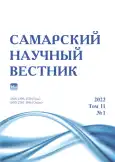Растительность регионального ландшафтно-ботанического памятника природы «Аландский бор» (Кваркенский район Оренбургской области)
- Авторы: Назаренко Н.Н.1, Похлебаев С.М.1, Исмухамбетов А.А.1
-
Учреждения:
- Южно-Уральский государственный гуманитарно-педагогический университет
- Выпуск: Том 11, № 1 (2022)
- Страницы: 99-105
- Раздел: Биологические науки
- URL: https://journals.rcsi.science/2309-4370/article/view/108329
- DOI: https://doi.org/10.55355/snv2022111112
- ID: 108329
Цитировать
Полный текст
Аннотация
Проведено детальное исследование растительности ландшафтно-ботанического памятника природы «Аландский бор» (Кваркенский район Оренбургской области). Заложено 47 пробных площадей и проведен их математический анализ. Растительность бора характеризуется сравнительно высокими показателями фиторазнообразия и доминирования. Во всех описаниях отмечен 71 вид сосудистых растений (из которых 3 вида внесены в Красную книгу Оренбургской области (2019 г.)), преобладают 15-ти видовые сосновые лесные растительные сообщества с доминированием в кустарниковом и травяном ярусах типичных степных видов. Установлено, что сосняки Аландского бора представляют собой лесо-степные амфиценозы. Методами многомерной статистики определено 13 растительных ассоциаций, биотопы которых практически не отличаются по режимам ведущих абиотических факторов. Установлено, что типы лесорастительных условий Аландского бора соответствуют типам AB₁ и AB₁₋₂ осветленного типа экологической структуры древостоев в рамках типологии степных лесов А.Л. Бельгарда. Определенные ассоциации сосняков формируют ряды ординации – сильвантный степных сосняков пырейных и амфиценотический степных сосняков с травостоем из типичных степантов. Установлено, что ведущими факторами, определяющими ценотическую структуру лесной растительности бора, являются режим содержания в почве кальция и азота, почвенное увлажнение, кислотность почв и порозность (аэрированность) почв. Факторами дискриминации биотопов также являются термоклимат (радиационный баланс), криоклимат (суровость зим или отрицательные зимние температуры), режим освещенности и солевой режим почв.
Полный текст
Открыть статью на сайте журналаОб авторах
Назар Николаевич Назаренко
Южно-Уральский государственный гуманитарно-педагогический университет
Email: nnazarenko@hotmail.com
доктор биологических наук, профессор кафедры химии, экологии и методики обучения химии
Россия, ЧелябинскСергей Михайлович Похлебаев
Южно-Уральский государственный гуманитарно-педагогический университет
Email: istina48@mail.ru
доктор педагогических наук, профессор кафедры общей биологии и физиологии
Россия, ЧелябинскАртур Амерович Исмухамбетов
Южно-Уральский государственный гуманитарно-педагогический университет
Автор, ответственный за переписку.
Email: artur.ismuhambetov.99@bk.ru
студент естественно-технологического факультета
Россия, ЧелябинскСписок литературы
- Бельгард А.Л. Степное лесоведение. М.: Лесная промышленность, 1971. 336 с.
- Чибилев А.А. Природное наследие Оренбургской области. Оренбург: Оренбургское книжное издательство, 1996. 384 с.
- Потапова Н.А., Назырова Р.И., Забелина Н.М., Исаева-Петрова Л.С., Коротков В.Н., Очагов Д.М. Сводный список особо охраняемых природных территорий Российской Федерации (справочник). Ч. II / отв. ред. Д.М. Очагов. М.: ВНИИприроды, 2006. 364 с.
- Зеленая книга Оренбургской области: Кадастр объектов оренбургского природного наследия / под науч. ред. А.А. Чибилева. Оренбург: Издательство «ДиМур», 1996. 260 с.
- Ханина Л.Г., Смирнов В.Э., Бобровский М.В. Новый метод анализа лесной растительности с использованием многомерной статистики (на примере заповедника «Калужские засеки») // Бюллетень Московского общества испытателей природы. Отдел биологический. 2002. Т. 107, № 1. С. 40-48.
- McCune B., Grace J.B. Analysis of ecological communities. MjM SoftWare Design, 2002. 300 p.
- Legendre L., Legendre P. Numerical ecology. Amsterdam: Elsevier Science B.V., 1998. 853 p.
- Мэгарран Э. Экологическое разнообразие и его измерение / пер. с англ. Н.В. Матвеевой; под ред. Ю.И. Чернова. М.: Мир, 1992. 184 с.
- Тихомиров В.Н. Методы анализа биологического разнообразия. Минск: БГУ, 2009. 87 с.
- Didukh Ya.P. The ecological scales for the species of Ukrainian flora and their use in synphytoindication. Kiev: Phytosociocentre, 2011. 176 p.
- Persson S. Ecological indicator values as an aid in the interpretation of ordination diagrams // Journal of Ecology. 1981. Vol. 69, № 1. P. 71-84.
- Красная книга Оренбургской области: Редкие и находящиеся под угрозой исчезновения виды животных, растений и грибов. Воронеж: ООО «Мир», 2019. 488 с.
- Рябинина З.Н., Князев М.С. Определитель сосудистых растений Оренбургской области. М.: Товарищество научных изданий КМК, 2009. 758 с.
- Терентьев П.В. Метод корреляционных плеяд // Вестник Ленинградского государственного университета. 1959. № 9. С. 137-141.
Дополнительные файлы









